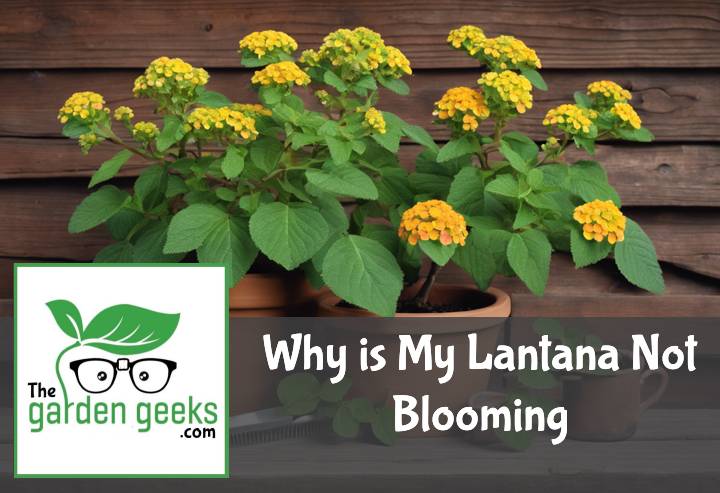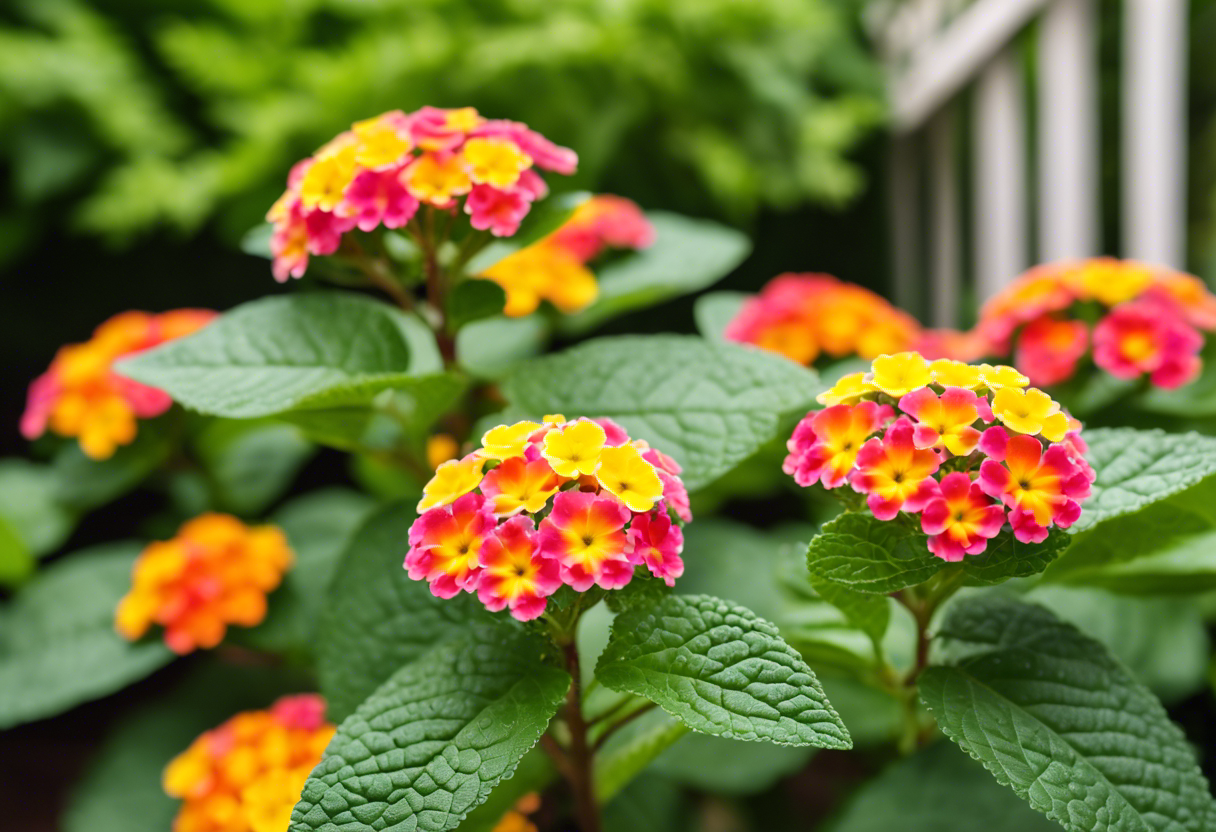Ever found yourself scratching your head, wondering Why is My Lantana Not Blooming? Trust me, I’ve been there. One moment you’re admiring the vibrant colors of your lantana bush, and the next, it’s as if they’ve gone on strike – refusing to bloom.
Don’t fret! It’s not a lost cause. In fact, understanding why this happens could be your first step towards a garden full of blooming lantanas. So buckle up, we’re about to dive into the world of these stubborn yet charming flowers. Keep reading about Why is My Lantana Not Blooming? (The Solution).
Key Takeaways
- Lantana may not bloom due to insufficient sunlight, improper watering, lack of nutrients, or pests/diseases.
- Ensure your plant gets at least 6 hours of sunlight daily.
- Water lantana when the top inch of soil is dry and avoid overwatering.
- Fertilize with a balanced fertilizer during the growing season for nutrient supply.
- Regularly check for pests like whiteflies or diseases such as powdery mildew and treat accordingly.
Understanding Lantana Blooming
Let’s dive into the fascinating world of botanical science to understand why your lantana might not be blooming. We’ll start by getting to know the lantana plant and its blooming process. This will help us figure out what could be going wrong with your garden’s star performer.
What is Lantana?
Lantana, my friend, is a vibrant and hardy shrub that hails from tropical regions. It’s one of those flowering shrubs that can turn any garden into a riot of colors. Known for their clusters of tiny flowers, lantanas are real showstoppers in any landscape.
There are different types of lantana, each with its own unique charm. But no matter the type, all lantanas share some common characteristics. They love sun, they’re drought-tolerant, and they have this knack for attracting butterflies and hummingbirds.
Typically found in warm climates, these tropical plants thrive in environments where there’s plenty of sunlight and well-drained soil. So if you’re wondering ‘Why is My Lantana Not Blooming‘, it might be time to take a closer look at its living conditions.
How Does Lantana Bloom?
Now onto the main event – the blooming! The blooming cycle of a lantana involves several stages driven by factors like sunlight exposure, temperature, and water availability.
The first stage involves bud formation which happens when our lantana gets enough light and warmth. Next comes the flowering stage where those buds burst open into beautiful clusters of flowers.
But here’s the catch – if any of these factors aren’t just right (too little sun or too much water), then your lantana might throw a tantrum and refuse to bloom. So understanding these factors affecting bloom can be your first step towards solving the mystery of ‘Why is My Lantana Not Blooming‘.
Remember, garden care tips aren’t just about watering and fertilizing. They’re also about understanding the unique needs of each plant in your garden. And when it comes to lantanas, a little bit of knowledge can go a long way in ensuring a spectacular bloom.
Common Reasons for Non-Blooming Lantanas
Ever wondered, “Why is My Lantana Not Blooming?” Well, it’s usually down to three main culprits: inadequate sunlight exposure, improper watering practices, and nutrient deficiency. Let’s dive into these issues.
Inadequate Sunlight Exposure
First off, sunlight for lantanas is like coffee for us humans – they need it to kickstart their day and bloom beautifully. If your lantana isn’t getting enough rays, it might just sulk by not blooming.
The effects of inadequate sunlight on plants, especially lantanas, can be pretty dramatic. They love the sun and require at least 6 hours of direct light daily. So make sure your plant gets its daily dose of sunshine!
Improper Watering Practices
Next up on the list of non-blooming lantanas causes is watering – too much or too little can both be problematic. You see, watering lantanas is a bit of a Goldilocks situation; it needs to be just right.
Overwatering or underwatering your plant can lead to stress and hinder blooming. The key here is balance! Water deeply but infrequently, allowing the soil to dry out between waterings.
Nutrient Deficiency
Lastly, we have nutrient deficiency. Just like you wouldn’t feel great running a marathon without proper nutrition, your lantana won’t bloom if it’s lacking certain nutrients.
When it comes to lantana nutrient needs, they require a balanced fertilizer with equal parts nitrogen, phosphorus, and potassium. Lack of these nutrients can lead to poor growth and fewer blooms.
So there you have it! These are some common reasons why your lantana might not be showing off its beautiful blooms. Remember that proper lantana plant care involves adequate sunlight, proper watering, and the right nutrients.
Diagnosing Your Lantana’s Problem
To figure out why is my Lantana not blooming, it’s crucial to play detective. You see, a non-blooming Lantana can be due to several reasons like inadequate sunlight, improper watering, or poor soil nutrients. So, let’s get into the nitty-gritty of these Lantana plant problems.
Assessing Sunlight and Location
First off, let’s talk about the sun. Lantanas love basking in full sunlight. If your plant is tucked away in a shady corner, that might just be why it’s not blooming. Check if your plant gets at least 6 hours of direct sunlight daily – that’s the minimum sunlight requirement for Lantana. Also, consider its location; a spot with good air circulation helps prevent diseases which could affect blooming.
Evaluating Watering Routine
Next up – water! Overwatering or underwatering can both lead to a non-blooming Lantana. A soggy soil can cause root rot while too dry soil can stress out the plant. The trick is to keep the soil evenly moist but not waterlogged. So take a moment to evaluate your watering routine; if you’re unsure whether you’re doing it right, stick your finger about an inch into the soil – if it feels dry, it’s time to water.
Checking Soil Nutrient Levels
Lastly, let’s dig into soil nutrients because they play a huge role in blooming. If your lantana isn’t flowering as expected, it might be due to nutrient deficiency in the soil. A simple way of checking this is by using a home testing kit available at most garden centers. Remember: healthy soil equals happy plants! So don’t skimp on those essential nutrients if you want your lantana to bloom beautifully.
Solutions to Encourage Lantana Blooming
Alright, let’s get down to business. Why is My Lantana Not Blooming? Well, it could be due to inadequate sunlight exposure, improper watering techniques or poor soil nutrients. But don’t worry! We’ve got some top-notch lantana blooming solutions for you.
Adjusting Sunlight Exposure
First off, we need to talk about sunlight exposure for lantanas. These plants are sun lovers and thrive under full sun conditions. So if your lantana is playing hide and seek with the sun, it might just be the reason why it’s not blooming.
Now, you might think “well, I can’t control the sun”, but what you can do is adjust where your plant is located. Try moving your lantana to a spot where it can bask in at least six hours of direct sunlight daily. This is considered the optimal sunlight for lantanas, and making this adjustment can encourage those beautiful blooms to pop out.
Modifying Watering Techniques
Next up on our list of lantana blooming solutions is watering techniques. You see, lantanas aren’t big fans of overwatering. They prefer their soil slightly dry rather than soaking wet.
So how do we modify our watering practices? It’s simple – water your plant deeply but infrequently. Wait until the top inch of soil feels dry before giving it another drink. This way, you’ll promote healthy root growth which in turn will promote lantana blooming.
Enhancing Soil Nutrients
Last but definitely not least, let’s talk about soil nutrients. Lantas love well-drained soils rich in organic matter. If your soil isn’t up to par, it could be hindering your plant’s ability to bloom.
To enhance the nutrient content of your soil, consider adding compost or a slow-release fertilizer. This will provide the necessary soil nutrients for lantanas and stimulate those stunning blooms we all love. Remember, a well-fed lantana is a blooming lantana!
Preventive Measures for Future Blooming Issues
Preventive measures are your best friend when it comes to avoiding future blooming issues with your Lantana. Regular pruning, seasonal fertilizing, and monitoring plant health are all part of the Lantana plant care package.
Regular Pruning Practices
Regular pruning is like a mini makeover for your Lantana. It keeps the plant looking fresh and encourages new growth. The benefits of pruning Lantana include preventing overcrowding and promoting better air circulation.
When you’re wondering, ‘Why is My Lantana Not Blooming‘, consider if you’ve been skipping on the snipping! The key to preventing blooming issues with pruning lies in timing and technique. Late winter or early spring is usually the best time for a good prune.
Seasonal Fertilizing Tips
Next up, let’s talk about feeding your Lantana. Proper fertilization can be a game-changer for bloom production and overall plant health.
Fertilizers are like multivitamins for plants, providing them with essential nutrients they might not get from soil alone. So, if you’re dealing with a case of ‘blooms gone AWOL’, try giving your plant some nutrient love!
Remember, over-fertilization can be as harmful as under-fertilization. So follow those seasonal fertilizing tips, folks!
Monitoring Plant Health
Lastly, keep an eye on your Lantana’s health status. Regularly checking up on its leaves, stems, and roots can help you spot any potential problems early on.
Signs of healthy Lantanas include vibrant green leaves and sturdy stems while wilting leaves or discolored spots could indicate trouble brewing beneath the surface.
So there you have it – regular pruning, seasonal fertilizing, and monitoring plant health are three simple yet effective preventive measures for future blooming issues. Here’s to happy, blooming Lantanas!
To Wrap Up
So, just like a toddler refusing to eat broccoli, your Lantana might be throwing a blooming tantrum for various reasons. It could be the soil, sunlight, water or even those pesky pests. But don’t sweat it! You’ve got this!
Check out Why is My Lantana Not Blooming for more insights. Now go and show that Lantana who’s boss!





